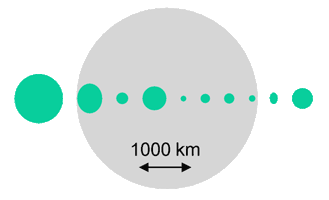|
|
9 Metis
| Discovery A |
| Discoverer |
A. Graham |
| Discovery date |
April 25, 1848 |
Alternate
designations |
1974 QU2 B |
| Category |
Main belt |
| Orbital elements C D |
|
Epoch July 14, 2004 (JD 2453200.5)
|
| Eccentricity (e) |
0.122 |
| Semi-major axis (a) |
357.052 Gm
(2.387 AU) |
| Perihelion (q) |
313.556 Gm
(2.096 AU) |
| Aphelion (Q) |
400.548 Gm
(2.678 AU) |
| Orbital period (P) |
1346.815 d
(3.69 a) |
| Mean orbital speed |
19.28 km/s |
| Inclination (i) |
5.576° |
Longitude of the
ascending node (Ω) |
68.982° |
Argument of
perihelion (ω) |
5.489° |
| Mean anomaly (M) |
274.183° |
| Physical characteristics |
| Dimensions |
235—165 km1 |
| Mass |
4.6—1018 kg
(estimation) |
| Density |
2 g/cm³
(estimation) |
| Surface gravity |
0.036 m/s²
(estimation) |
| Escape velocity |
0.081 km/s
(estimation) |
| Rotation period |
0.2116 d 2 |
| Spectral class |
S-type 3 |
| Absolute magnitude |
6.28 |
| Albedo |
0.160 3 |
Mean surface
temperature |
~177 K |
9 Metis (mee'-tis) is one of the largest Main belt asteroids. It is composed of silicates and metallic nickel-iron.

Size comparison: the first 10 asteroids profiled against Earth's Moon. From left to right, 1 Ceres, 2 Pallas, 3 Juno, 4 Vesta, 5 Astraea, 6 Hebe, 7 Iris, 8 Flora, 9 Metis, and 10 Hygiea. [Source]
Metis was discovered by Andrew Graham on April 25, 1848; his only asteroid discovery. It is also the only asteroid to have been discovered as a result of observations from Ireland. Its name comes from the mythological Metis, a Titaness, daughter of Tethys and Oceanus (and thus an Oceanid), who was the first wife of Zeus and the mother of Athena. Zeus devoured her lest she bear a child more powerful than he.
Light curve data on Metis led to an assumption that it could have a satellite. However, subsequent observations failed to confirm this. [1] [2] Metis was later observed with the Hubble Space Telescope in 1993, which was able to resolve the irregular shape of the asteroid, but no satellites were detected. [3]
Metis has been observed occulting a star no less than 5 times.
Metis is also the name of a satellite of Jupiter.
Aspects
| Stationary, retrograd |
Opposition |
distance to earth (AU) |
maximum brightness |
Stationary, prograde |
conjunction to sun |
| January 19, 2006 |
March 3, 2006 |
1.35200 |
9.1 mag |
April 20, 2006 |
June 7, 2005 |
| May 4, 2007 |
June 23, 2007 |
1.64582 |
9.7 mag |
August 13, 2007 |
November 5, 2006 |
| September 24, 2008 |
November 5, 2008 |
1.13923 |
8.4 mag |
December 19, 2008 |
February 15, 2008 |
| February 23, 2010 |
April 11, 2010 |
1.53609 |
9.5 mag |
June 3, 2010 |
August 7, 2009 |
| June 11, 2011 |
July 28, 2011 |
1.53974 |
9.6 mag |
September 16, 2011 |
December 6, 2010 |
| November 23, 2012 |
January 2, 2013 |
1.13905 |
8.5 mag |
February 12, 2013 |
March 30, 2012 |
| March 26, 2014 |
May 15, 2014 |
1.64402 |
9.6 mag |
July 7, 2014 |
September 23, 2013 |
| July 25, 2015 |
September 6, 2015 |
1.35478 |
9.2 mag |
October 25, 2015 |
January 5, 2015 |
| January 11, 2017 |
February 22, 2017 |
1.31456 |
9.0 mag |
April 10, 2017 |
May 27, 2016 |
| April 28, 2018 |
June 17, 2018 |
1.65468 |
9.7 mag |
August 7, 2018 |
October 30, 2017 |
| September 14, 2019 |
October 27, 2019 |
1.16286 |
8.6 mag |
December 10, 2019 |
February 8, 2019 |
Links
… | Previous asteroid | 9 Metis | Next asteroid | …
The minor planets
Vulcanoids | Main belt | Groups and families | Near-Earth objects | Jupiter Trojans
Centaurs | Damocloids | Comets | Trans-Neptunians (Kuiper belt | Scattered disc | Oort cloud)
For other objects and regions, see: Binary asteroids, Asteroid moons and the Solar system
 |
|

